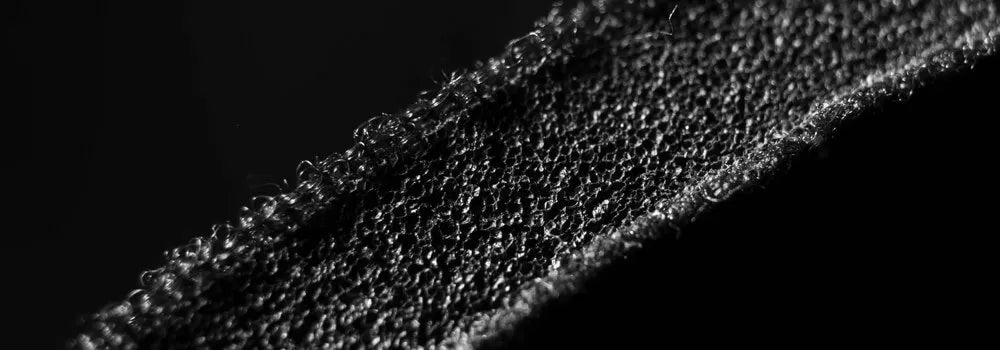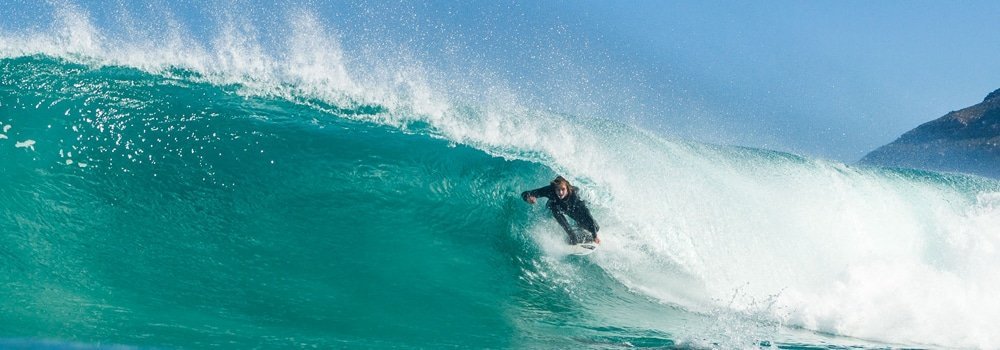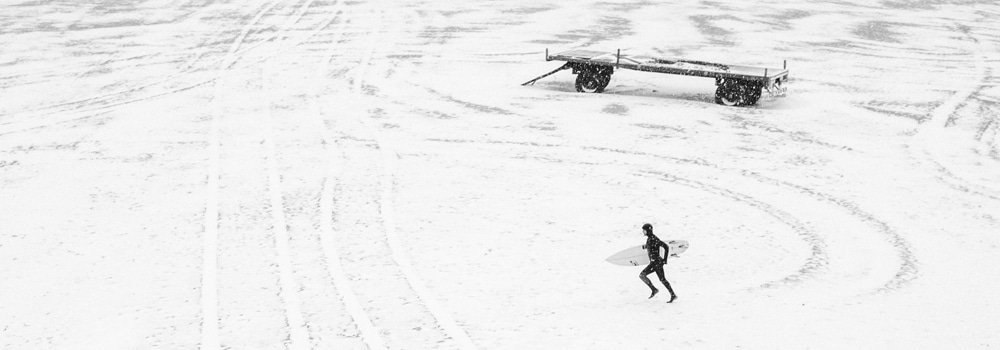Neoprene wetsuit thickness

Neoprene thickness
Different water temperatures require different wetsuit neoprene thicknesses. What thicknesses are used in a wetsuit? Thicker neoprene makes a warmer wetsuit due to the higher thermal insulation grade of thicker neoprene. Neoprene thickness ranges from 2mm for summer wetsuits to 7mm for extreme winter conditions. What kind and thickness of wetsuit you need, depends on your location, season and water temperatures.
Wetsuit thicknesses: How does it work?
Brands usually advertise their wetsuit neoprene thicknesses as 3/2, 4/3, 5/4, 6/4, etc. This indicates the different thicknesses in millimetres mostly used in the wetsuit. 3/2 for instance, means this wetsuit’s main panels are 3mm and 2mm thick. Normally, the chest and back panels are made out of thicker neoprene foam for extra warmth. Arms, shoulders, and legs are usually thinner for more flexibility. Thin summer wetsuits range between 1mm and 3mm. Spring or autumn wetsuits are normally made with 4mm and 3mm panels. You’ll find winter wetsuits in 5/4mm or 6/4mm.
How is neoprene thickness measured?
We measure neoprene wetsuit thickness by measuring the neoprene foam thickness before the inside and outside lining are applied. The overall thickness including lining is sometimes thicker than the neoprene thickness specified. However, be aware that some brands measure the thickness including lining. This results in a thinner foam thickness than advertised, which makes a colder wetsuit than you might expect. It’s easy to see the true neoprene thicknesses on the arm, leg and neck cuffs where the neoprene foam is exposed. It’s harder to determine the thickness of the chest and back panels. These panels don’t have cut off edges to inspect. There are special material thickness gauges available to check neoprene thicknesses in case you want to double-check your wetsuit’s thickness.
Thick or thin neoprene?
To cut a long story short, to stay warm when you surf, you need a wetsuit that keeps the water where it belongs: in the ocean. Add a millimetre when you feel cold quickly or when it’s very windy. Vice versa, you can go a bit thinner when the ocean surface conditions are a bit more favourable. When the water temperature drops below 10 degrees Celsius, it’s advisable to wear a hood.
Water temperature
The location and season you are planning to use the wetsuit in, plays a huge role in choosing the right wetsuit neoprene thickness. Water and air temperatures at the time of the year are things to take into account. To give you an idea, below are our general recommendations of the best wetsuit neoprene thicknesses to use in different water temperatures.
2/2 mm wetsuit: water temperatures above 20°C
A 2/2 mm, also called a 2.0 or 2mm, is a very thin summer wetsuit or springsuit. 2/2 mm wetsuits usually come in flatlock stitching which is not waterproof. 2/2 mm refers to the main neoprene thicknesses used in individual panels to stitch together a complete wetsuit. In this case, the neoprene is 2mm thick in most panels.
3/2 mm wetsuit: water temperatures around 15~20°C
A 3/2 mm, also called a 3.2 or 3mm is a regular thickness summer wetsuit or springsuit. The main neoprene thicknesses used in individual panels in a 3/2 are 3mm and 2mm. Usually, the thicker 3mm panels are used in the main body panels for extra warmth and the 2mm thick panels are used in the more flexible areas such as arms, shoulders and back lower legs.
4/3 mm wetsuit: water temperatures around 12~15°C
A 4/3 mm, also called a 4.3 or 4mm is the most common thickness for a spring or autumn season wetsuit. The 4mm panels are located in the body and upper legs panels. The 3mm panels are in the arms and lower legs where they allow for more flexibility. The collar panel is usually thinner than 3mm, but this is usually not mentioned in the thickness description of a wetsuit.
5/3 mm wetsuit: water temperatures around 9~11°C
A 5/3 mm, also called a 5.3 or 5mm is a common winter wetsuit thickness. Similar to a 4/3, the thicker 5mm panels are used in the main body panels for extra warmth and the 3mm thick panels are used in the more flexible areas such as arms, shoulders and back lower legs. A 5/3 mm thickness can have panels used that are in between 5mm and 3mm but are not always mentioned in the thickness description. Thus, it could be that your side panels are 4mm for example. Here the collar panel is also thinner than 3mm and not mentioned in the wetsuit’s thickness description.
5/4/3 mm wetsuit: water temperatures around 8~10°C
A 5/4/3 mm, also called a 5.4.3 or 5mm is a slightly thicker winter wetsuit, similar to a 5/4 and 5/3 mm. Usually, the thicker 5mm panels are used in the chest and back panels for extra warmth. The 4mm panels are mainly used in the upper legs, while the 3mm panels are used in the more flexible areas such as arms, shoulders and back lower legs. A 5/4/3 mm thickness uses panels that are only 5, 4 or 3 mm, except the not mentioned thinner collar panel.
5/4 mm wetsuit: water temperatures around 8~10°C
A 5/4 mm, also called a 5.4 or 5mm is the most common thickness for a winter wetsuit. It is slightly warmer than a 5/3 mm due to the extra mm thickness in the arms. The same story applies here where 5mm panels are used on main body panels and upper legs, while the 4mm panels are used on the flex areas such as arms, shoulders and back lower legs. A 5/4 mm wetsuit can have panels used between 5 and 4 mm, but are not always mentioned in the thickness description. So it could be that your side panels are 4.5mm for example. The collar panel is usually thinner than 3mm and is not mentioned.
6/4 mm wetsuit: water temperatures below 8°C
A 6/4 mm, also called a 6.4 or 6mm is a less common thickness for an extremely warm winter wetsuit, usually combined with a built-in hood. Panel thicknesses range between 6 and 4mm, with thickest panels chest and back panels, and thinner 4mm panels used in arms and shoulders for easier paddling in this thick wetsuit. It could be that your side panels are 5mm for example, but this is not always mentioned in the thickness description.
6/5/4 mm wetsuit: water temperatures below 6°C
A 6/5/4 mm, also called a 6.5.4 or 6mm, is a rare thickness for an extremely warm, but stiffer winter wetsuit, usually combined with a built-in hood. The panels range between 6mm and 4 mm with thicker panels used in the body as usual and thinner panels in the flex areas.
6/5 mm wetsuit: water temperatures below 5°C
A 6/5 mm, also called a 6.5 or 6 mm, is an uncommon but extremely warm winter wetsuit. This wetsuit is mostly combined with a built-in hood. Panels range between 6mm and 5 mm. These suits are extremely warm.



